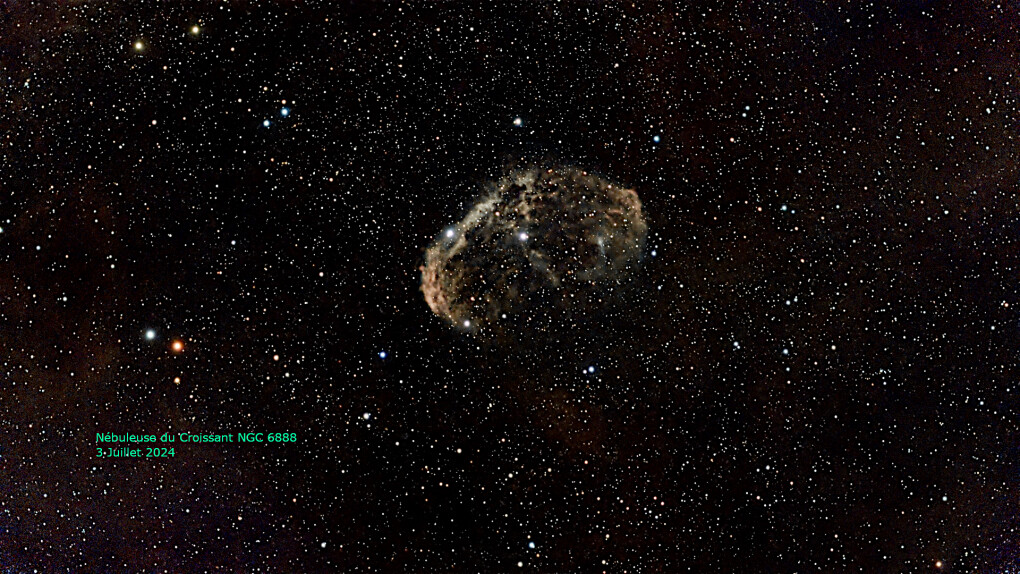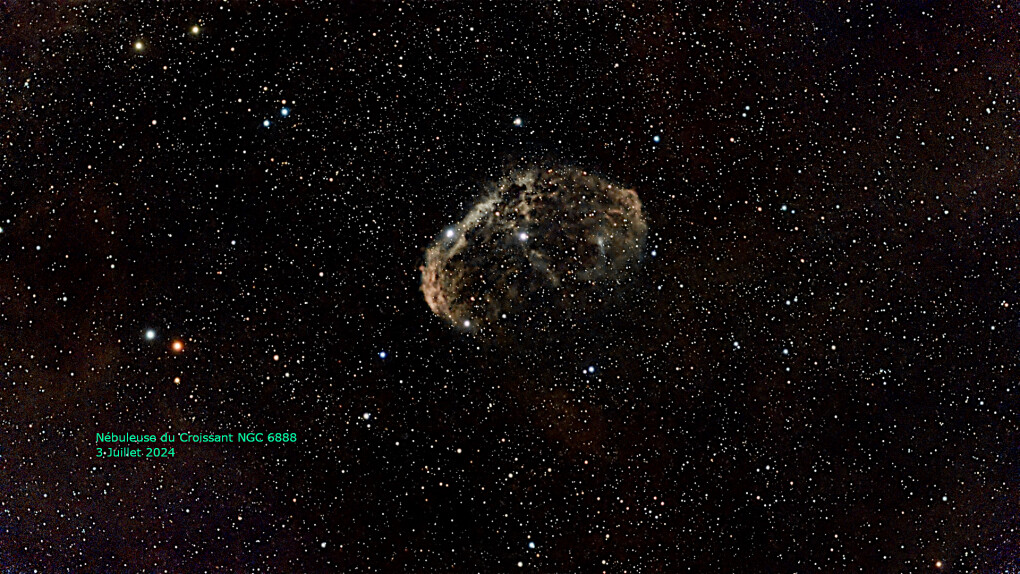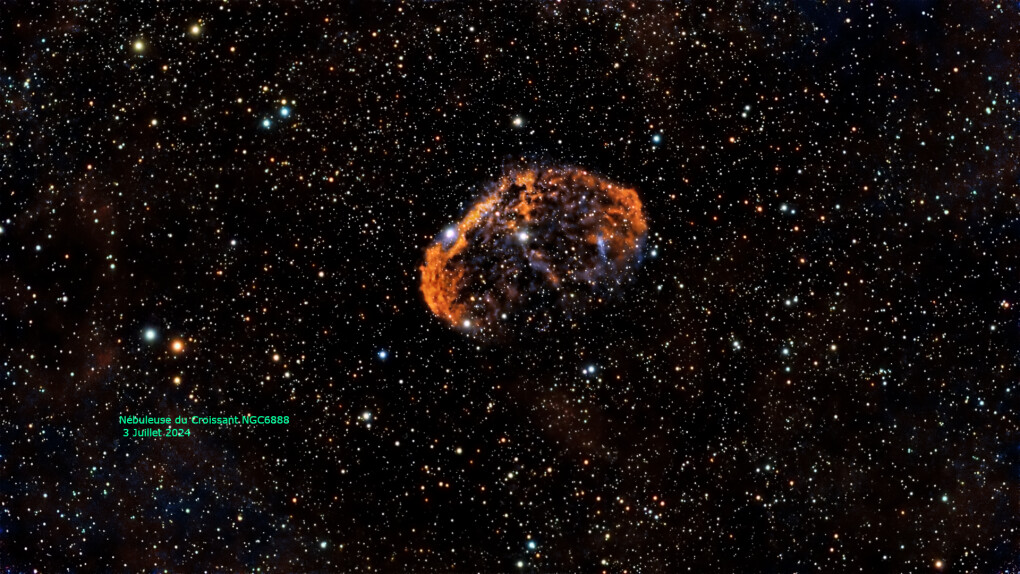Chez Messier, Brahé et Galilée : la taverne du gentleman astronome
- 4 246 réponses
- 100 participants
- 131 923 vues
- 76 followers
Dr Pouet
52038
Membre d’honneur
Membre depuis 21 ans
Sujet de la discussion Posté le 15/07/2007 à 13:02:09Chez Messier, Brahé et Galilée : la taverne du gentleman astronome
Un endroit dédié aux discussions astronomiques : que regardez-vous, quand, comment ? Explications scientifiques, liens utiles, conseils aux débutants...
Tous les amateurs d'astronomie sont les bienvenus !

Tous les amateurs d'astronomie sont les bienvenus !
Sylvain alias leo
1722
AFicionado·a
Membre depuis 9 ans
3401 Posté le 16/06/2024 à 17:46:23
Puisque vous en parlez, voici une entrevue très intéressante sur le sujet.
0
Celest1
5702
Je poste, donc je suis
Membre depuis 9 ans
3402 Posté le 16/06/2024 à 19:38:39
Le type est audible car il est passionné et puis c'est passionnant .. Mais pour résumé, rien ne permet encore d'expliquer ces phénomènes .. A chaque fois un OVNI reste pour nous, commun des mortels, un objet volant non identifié ..
Si ce sujet vous passionne plus que de raison ce soir il y a une émission spéciale sur France 5 pour garder les pieds sur terre
https://www.france.tv/france-5/la-fabrique-du-mensonge/saison-4/6075323-espace-les-fake-news-contre-attaquent.html

Si ce sujet vous passionne plus que de raison ce soir il y a une émission spéciale sur France 5 pour garder les pieds sur terre
https://www.france.tv/france-5/la-fabrique-du-mensonge/saison-4/6075323-espace-les-fake-news-contre-attaquent.html
0
101112
sonicsnap
90549
Posteur haute vélocité
Membre depuis 19 ans
3403 Posté le 17/06/2024 à 10:56:47
Un jour, j'ai vu un ovni et personne n'a jamais pu me donner une explication plausible de ce que ça pouvait être. Malheureusement, je n'ai pas eu l'idée de prendre des notes et mes souvenirs s'estompent. Je sais que c'était un 10 novembre vers 18 heures, mais je ne me souviens plus en quelle année. Enfin, j'ai quand même encore une image assez nette de l'apparence de l'objet. Je ne saurai jamais.
0
Sylvain alias leo
1722
AFicionado·a
Membre depuis 9 ans
3404 Posté le 17/06/2024 à 15:38:47
Citation de sonicsnap :
Un jour, j'ai vu un ovni et personne n'a jamais pu me donner une explication plausible de ce que ça pouvait être. Malheureusement, je n'ai pas eu l'idée de prendre des notes et mes souvenirs s'estompent. Je sais que c'était un 10 novembre vers 18 heures, mais je ne me souviens plus en quelle année. Enfin, j'ai quand même encore une image assez nette de l'apparence de l'objet. Je ne saurai jamais.
Donc c’était encore jour? Interessant
0
sonicsnap
90549
Posteur haute vélocité
Membre depuis 19 ans
3405 Posté le 17/06/2024 à 17:00:12
Je fermais mes volets. Il ne faisait peut-être pas complètement nuit c'est possible, mais ce n'est pas ça qui m'a frappé. Par contre le truc était très lumineux.
0
Ouatisit
4263
Squatteur·euse d’AF
Membre depuis 2 ans
3406 Posté le 22/06/2024 à 20:49:46
Anonyme
3407 Posté le 22/06/2024 à 21:23:28
je ne connaissais pas ce phénomène.
0
Ouatisit
4263
Squatteur·euse d’AF
Membre depuis 2 ans
3408 Posté le 22/06/2024 à 22:28:39
J’ai jeté un œil par la fenêtre, ciel dégagé, mais si la lune reste basse je risque de rien voir. Pour l’instant je vois que des chats qui se balladent dans la pelouse…
0
sonicsnap
90549
Posteur haute vélocité
Membre depuis 19 ans
3409 Posté le 23/06/2024 à 09:34:39
J'avais déjà entendu le mot "lunistice" mais j'ignorais de quoi il s'agissait. Intéressant, mais ça ne semble pas être un phénomène très spectaculaire?
0
Sylvain alias leo
1722
AFicionado·a
Membre depuis 9 ans
3410 Posté le 23/06/2024 à 17:18:12
0
Ouatisit
4263
Squatteur·euse d’AF
Membre depuis 2 ans
3411 Posté le 23/06/2024 à 18:42:21
Mmmm… le gars essaierait -il de nous dire que le hasard ça n’existe pas ? Que même dans le désordre il y a de l’ordre ? C’est perturbant.
0
sonicsnap
90549
Posteur haute vélocité
Membre depuis 19 ans
3412 Posté le 27/06/2024 à 16:16:22
Je me souviens d'une conférence de Hubert Reeves à la télé sur ce sujet. Mais une piqûre de rappel est loin d'être inutile!
0
Sylvain alias leo
1722
AFicionado·a
Membre depuis 9 ans
3413 Posté le 04/07/2024 à 13:27:23
Question de créer de l’activité sur la page… 
Voici ma dernière prise, dans la constellation du Cygne, à 5000 années lumières de la Terre, la nébuleuse du Croissant

Voici ma dernière prise, dans la constellation du Cygne, à 5000 années lumières de la Terre, la nébuleuse du Croissant

3
Anonyme
3414 Posté le 04/07/2024 à 14:04:23
belle prise 
0
sonicsnap
90549
Posteur haute vélocité
Membre depuis 19 ans
3415 Posté le 04/07/2024 à 14:44:20
Superbe! Je n'ai jamais vu cette nébuleuse. Quelle durée de pose?
0
kosmix
52570
AF, je suis ton père
Membre depuis 20 ans
3416 Posté le 04/07/2024 à 14:45:20
On dirait un astéroïde, enfin une patate quoi 
0
Putain Walter mais qu'est-ce que le Vietnam vient foutre là-dedans ?
Sylvain alias leo
1722
AFicionado·a
Membre depuis 9 ans
3417 Posté le 04/07/2024 à 14:47:27
Citation de sonicsnap :
Superbe! Je n'ai jamais vu cette nébuleuse. Quelle durée de pose?
Je l’ai prise sur deux nuits avec le Seestar environ 1200 images de 10s.
0
sonicsnap
90549
Posteur haute vélocité
Membre depuis 19 ans
3418 Posté le 04/07/2024 à 15:26:13
Ah bon, quand même.. Cette nébuleuse est-elle observable sans pose?
Il y a une nébuleuse que j'aurais aimé pouvoir prendre avec ce genre de technique, car elle est trop diffuse pour que j'aie pu l'observer avec certitude en direct, c'est la "Triffide" (Messier 20) dans le Sagittaire (il est vrai que de là où j'observais, j'étais gêné par un putain de lampadaire dans cette direction). Par contre, dans la même région du ciel, j'ai quand même pu voir la nébuleuse de "la Lagune" (M8).
Il y a une nébuleuse que j'aurais aimé pouvoir prendre avec ce genre de technique, car elle est trop diffuse pour que j'aie pu l'observer avec certitude en direct, c'est la "Triffide" (Messier 20) dans le Sagittaire (il est vrai que de là où j'observais, j'étais gêné par un putain de lampadaire dans cette direction). Par contre, dans la même région du ciel, j'ai quand même pu voir la nébuleuse de "la Lagune" (M8).
0
Sylvain alias leo
1722
AFicionado·a
Membre depuis 9 ans
3419 Posté le 04/07/2024 à 15:30:10
Citation de sonicsnap :
Ah bon, quand même.. Cette nébuleuse est-elle observable sans pose?
avec la pollution lumineuse ici, non
0
sonicsnap
90549
Posteur haute vélocité
Membre depuis 19 ans
3420 Posté le 04/07/2024 à 15:52:26
Oui, c'est toujours le même problème. Je pense que si je n'ai jamais pu voir la "Triffide", c'est pour la même raison puisque Charles Messier a bien réussi à l'observer, lui..
0
Sylvain alias leo
1722
AFicionado·a
Membre depuis 9 ans
3421 Posté le 06/07/2024 à 20:29:55
deuxième version en réduisant les verts et en amplifiant les rouges. Car lorsque je vois des images de cette nébuleuse prise par JWST elle est plutôt rouge et bleu. Mais tout ce que je réussi à amplifier c'est le orange??? J'ai lu qu'il aurait fallu que j'utilise un filtre Optolong L-eNHance (la prochaine fois?)


Et si on compare à JWST

Voici un article sur le sujet.


Et si on compare à JWST

Voici un article sur le sujet.
Spoiler - Cliquer ici pour lire la suite
Bien que la nébuleuse du Croissant soit brillante, il est notoirement difficile de capturer un portrait détaillé de la région pour de nombreux amateurs. Il y a beaucoup de lumière émise par l'hydrogène gazeux dans la région, mais cette fonctionnalité est largement manquée lors de l'utilisation d'un appareil photo reflex numérique de stock et d'un filtre à large spectre.
Tout d'abord, un appareil photo reflex numérique qui a été modifié pour l'astrophotographie, ou un appareil photo d'astronomie dédié est le meilleur. Ces caméras feront un bien meilleur travail d'enregistrement de la lumière sur la longueur d'onde de 656 nm, ce qui est précisément là que se trouve la majeure partie des détails dans NGC 6888.
Pour les nébuleuses du ciel profond riches en gaz hydrogène, un filtre à bande étroite conçu pour isoler cette caractéristique est recommandé. Il existe de nombreux filtres d'astrophotographie disponibles, mais un filtre h-alpha est sans doute le plus important. (Pour les appareils photo reflex numériques, je recommande le modèle à clip-in Astronomik).
Alternativement, vous pouvez photographier la nébuleuse du Croissant à l'aide d'un filtre qui isole plusieurs longueurs d'onde de lignes d'émission à bande étroite à la fois. Le filtre Optolong L-eNHance est l'un de ces filtres et celui utilisé pour l'image de NGC 6888 en haut de cette page.
Les filtres à double passage de bande qui ont la capacité de collecter de puissants détails Ha et OIII en un seul plan étaient destinés à des cibles comme la nébuleuse du Croissant. L'image ci-dessous n'a utilisé que 15 expositions de 5 minutes pour recueillir une quantité impressionnante de détails sur cette cible.
En plus d'une isolation impressionnante de gaz spécifiques, les images prises à l'aide d'un filtre à bande étroite bénéficient également d'étoiles plus petites et plus nettes qu'une image à large bande traditionnelle. Ils font également un travail incroyable en séparant la cible d'un ciel urbain pollué par la lumière.
Mon jardin est considéré comme une classe 6/7 sur l'échelle Bortle, et je compte sur les filtres de pollution lumineuse pour capturer des images de la maison. Vous trouverez ci-dessous une image du support de télescope équatorial que j'utilise pour l'astrophotographie, avec ma charge utile d'imagerie complète attachée.
Une configuration comme celle-ci est une configuration polyvalente pour capturer des objets du ciel profond de toutes tailles. Avec une longueur focale du télescope de 550 mm, il est considéré comme une plate-forme à champ large, bien qu'il s'agisse plus d'un champ de vision de milieu de gamme lorsqu'il est combiné avec la caméra CMOS à capteur 4/3 que j'utilise (ZWO ASI294MC Pro).
Bien que la nébuleuse du Croissant soit brillante, il est notoirement difficile de capturer un portrait détaillé de la région pour de nombreux amateurs. Il y a beaucoup de lumière émise par l'hydrogène gazeux dans la région, mais cette fonctionnalité est largement manquée lors de l'utilisation d'un appareil photo reflex numérique de stock et d'un filtre à large spectre.
Tout d'abord, un appareil photo reflex numérique qui a été modifié pour l'astrophotographie, ou un appareil photo d'astronomie dédié est le meilleur. Ces caméras feront un bien meilleur travail d'enregistrement de la lumière sur la longueur d'onde de 656 nm, ce qui est précisément là que se trouve la majeure partie des détails dans NGC 6888.
Pour les nébuleuses du ciel profond riches en gaz hydrogène, un filtre à bande étroite conçu pour isoler cette caractéristique est recommandé. Il existe de nombreux filtres d'astrophotographie disponibles, mais un filtre h-alpha est sans doute le plus important. (Pour les appareils photo reflex numériques, je recommande le modèle à clip-in Astronomik).
Alternativement, vous pouvez photographier la nébuleuse du Croissant à l'aide d'un filtre qui isole plusieurs longueurs d'onde de lignes d'émission à bande étroite à la fois. Le filtre Optolong L-eNHance est l'un de ces filtres et celui utilisé pour l'image de NGC 6888 en haut de cette page.
Les filtres à double passage de bande qui ont la capacité de collecter de puissants détails Ha et OIII en un seul plan étaient destinés à des cibles comme la nébuleuse du Croissant. L'image ci-dessous n'a utilisé que 15 expositions de 5 minutes pour recueillir une quantité impressionnante de détails sur cette cible.
En plus d'une isolation impressionnante de gaz spécifiques, les images prises à l'aide d'un filtre à bande étroite bénéficient également d'étoiles plus petites et plus nettes qu'une image à large bande traditionnelle. Ils font également un travail incroyable en séparant la cible d'un ciel urbain pollué par la lumière.
Mon jardin est considéré comme une classe 6/7 sur l'échelle Bortle, et je compte sur les filtres de pollution lumineuse pour capturer des images de la maison. Vous trouverez ci-dessous une image du support de télescope équatorial que j'utilise pour l'astrophotographie, avec ma charge utile d'imagerie complète attachée.
Une configuration comme celle-ci est une configuration polyvalente pour capturer des objets du ciel profond de toutes tailles. Avec une longueur focale du télescope de 550 mm, il est considéré comme une plate-forme à champ large, bien qu'il s'agisse plus d'un champ de vision de milieu de gamme lorsqu'il est combiné avec la caméra CMOS à capteur 4/3 que j'utilise (ZWO ASI294MC Pro).
2
[ Dernière édition du message le 06/07/2024 à 20:33:38 ]
Anonyme
3422 Posté le 06/07/2024 à 20:38:36
beau boulot 
0
Anonyme
3423 Posté le 06/07/2024 à 20:39:31
intéressant.
0
Ouatisit
4263
Squatteur·euse d’AF
Membre depuis 2 ans
3424 Posté le 06/07/2024 à 21:13:13
Elle est belle ta photo Sylvain tout en sachant que tu l’as faite de ton jardin avec tes propres moyens  . Le JWST lui il s’en moque de la pollution lumineuse de là où il est, et en plus c’est le King de la photo infrarouge, le plus perfectionné jamais construit.
. Le JWST lui il s’en moque de la pollution lumineuse de là où il est, et en plus c’est le King de la photo infrarouge, le plus perfectionné jamais construit.
0
Sylvain alias leo
1722
AFicionado·a
Membre depuis 9 ans
3425 Posté le 06/07/2024 à 21:21:39
Citation de docteur benway :
intéressant.
J'avais posté un entretien avec Luc Dini, intéressant effectivement.
Citation de Ouatisit :
...et en plus c’est le King de la photo infrarouge, le plus perfectionné jamais construit.
J'ai trouvé une procédure pour retirer le filtre infrarouge sur mon EOS 6D.
C'est ma prochaine opération.
https://garyhonislegacy.com/rebelmod450d1.html
0
[ Dernière édition du message le 06/07/2024 à 21:32:22 ]
- < Liste des sujets
- Charte
